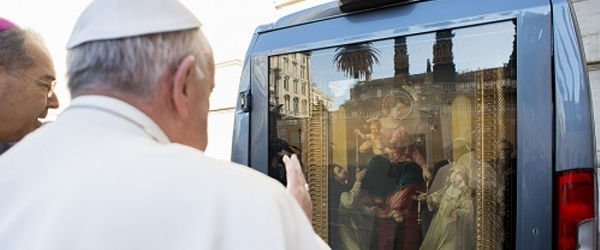At World Youth Day last month, Our Holy Father Pope Benedict XVI, gave us a new “doctor” of the Church — St. John of Avila, a 16th-century priest and spiritual writer.
St. John used to say that the Mass contains the whole history of salvation.
St. John used to say that the Mass contains the whole history of salvation. In the Mass, he once wrote: “You will see a semblance of the love shown in our Lord’s incarnation, nativity, life and death … These mysteries are renewed in the Holy Sacrifice of the altar.”
St. John used to say that the Mass contains the whole history of salvation. In the Mass, he once wrote: “You will see a semblance of the love shown in our Lord’s incarnation, nativity, life and death … These mysteries are renewed in the Holy Sacrifice of the altar.” The new translation of the Mass that we will begin using this Advent helps us to better express and experience this beautiful truth. In the Mass, each one of us receives the gift of communion with God in the Body and Blood of his Son. That was the purpose of God’s loving plan for history. That is why he sent his only begotten Son into the world. So when we go to Mass we should be filled with joy. We are drawing near to God — and he is drawing near to us! This should make us happy. But also humble and contrite, because we realize that we are not yet the holy people God wants us to be. That is why we confess our sins and ask our Father’s mercy at the start of every Mass. In our new translation we return to the ancient way of praying for God’s pardon and strength. We will now pray: “I have greatly sinned … through my fault, through my fault, through my most grievous fault.” As we pray these words, we will strike our breasts lightly over our hearts with our right fist. This is a beautiful gesture found in the Bible that symbolizes how sorry we are for our sins. Older Catholics will remember that this is the way they used to pray the Latin “Confiteor” (“I confess”). And I believe that if we pray this prayer sincerely, it can help us grow in our spiritual lives. It will give us greater humility. It will remind us that we always need God’s help and that we always need to respond to the graces he gives us. Praying these words will also help us to grow in confidence that God is always with us. It will help us to trust that he will always give us the graces we need to grow in virtue and holiness.
I pray that this new translation will help us to think more deeply about our faith in Jesus and our faith in God — the Father, the Son, and the Holy Spirit.
In the Mass, after we ask God for mercy, we praise him by singing with the angels in heaven, using the words they sang on the night that Christ was born. Our new translation will bring out more of the biblical rhythms and language in the “Gloria.” I find that this new translation is always reminding us that the liturgy’s language is not like ordinary speech or prose. The liturgy’s meanings, like the meanings of sacred Scripture, unfold in poetic rhythms and repetitions. Like the language of the Scriptures, the language of our liturgy allows us to hear and express different shades of meanings and emotions every time we worship. At the same time, I notice this new translation uses more precise language to describe Jesus Christ and his relationship to the Father and the Holy Spirit in the Blessed Trinity. In the “Gloria,” we will now praise Jesus by the ancient title: “the Only Begotten Son of God, born of the Father before all ages.” We find a similar change in the Nicene Creed. Where currently we profess that we believe Jesus is “one in being” with the Father, in our new translation we will say that he is “consubstantial” with the Father. This is not a familiar word to us. In fact, it translates the one word in our Creed that is not found in the Bible. The Church Fathers came up with this word to defend Jesus Christ’s divine identity against heretics who claimed that he was not really God. This reminds us again that what we pray shapes what we believe. So it matters what language we use when we are praying to Jesus. How we express our beliefs has a big effect on how we understand who he is, the authority of his teaching, and how he works in our lives. So I pray that this new translation will help us to think more deeply about our faith in Jesus and our faith in God — the Father, the Son, and the Holy Spirit. Let’s keep praying for each other this week. And let’s ask our Blessed Mother to helps us have a greater desire to know the truths of our faith and to live them every day. This is the third of a four-part series of columns that Archbishop Gomez intends to write on the translation of the Mass. To learn more, visit the U.S. bishops’ website: “Welcoming the Roman Missal, Third Edition” (www.usccb.org/romanmissal). Follow Archbishop Gomez at: www.facebook.com/ArchbishopGomez.

